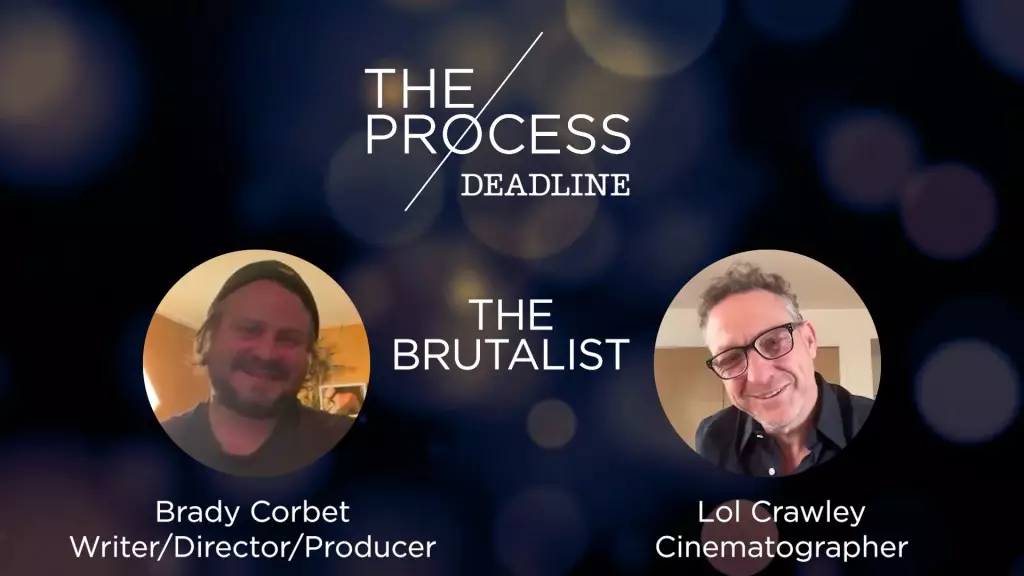“The Brutalist” stands as a testament to the remarkable synergy between director Brady Corbet and cinematographer Lol Crawley. Their collaboration isn’t merely a professional arrangement; it reflects an evolving partnership that has gained notable recognition through their previous works, “Vox Lux” and “The Childhood of a Leader.” Over the past decade, this duo has cultivated a distinctive visual and narrative style, characterized by an ambitious approach that elicits diverse responses from both critics and audiences alike. As Corbet himself reflects in his conversation with Crawley for Deadline’s series, the very essence of their filmmaking often oscillates between being perceived as both lofty and inaccessible.
This duality of perception highlights a crucial aspect of their creative process: the internal vision versus the external execution. Corbet acknowledges a certain myopia in his writing phase, which contrasts sharply with the expansive nature of filmmaking that emerges in pre-production. He describes his narrative framework as a tightly knit circle that, throughout the collaborative process, transforms into a much larger universe. This collaborative aspect is pivotal, as Corbet emphasizes the integral role played by a cohesive team. It is through collective contributions from department heads to crew members that the intricate tapestry of cinema is woven, visually and thematically expanding the film’s original confines.
In their insightful dialogue, Crawley elaborates on how the film’s ambitious nature influences their cinematic language, a term that, while often overused, speaks volumes in context. The idea of “cinematic” for Crawley crystallizes in how they approach shooting ambitious scenes: through careful consideration of spatial dynamics and performance. It’s not just the concept of grandiosity; it’s the art of achieving impactful storytelling within a single shot that captivates the viewer.
Corbet and Crawley’s perspective invites a broader conversation about the nature of ambition in filmmaking. Rather than equating ambition solely with grand narratives or elaborate productions, they redefine it to encompass the subtleties within the filmmaking process. This shifts the focus from mere spectacle to a more nuanced understanding of cinema as a dynamic collaboration of various elements. The synthesis of visual artistry and narrative depth often emerges from the most unexpected places within the production process, a realization Corbet treasures.
Yet, amidst the creative triumphs lie the grueling realities of life on a film set. Corbet candidly shares the exhausting nature of filmmaking, humorously remarking on the toll it takes on personal wellbeing. The emotionally charged atmosphere of endless takes and meticulous adjustments can create a whirlwind of tension, manifesting as fatigue and frustration among the cast and crew.
Crawley adds an intriguing perspective on what it’s like for outsiders to visit a set, emphasizing the disconnection they might feel. For him, the reality of a film set often resembles a strange loop of repetition, where individuals seem out of sync with one another. This stark depiction counters the glamorized image often associated with filmmaking, prompting a greater appreciation for those who willingly navigate this demanding environment.
At its core, “The Brutalist” tells an impactful story rooted in resilience and reinvention. Set in the post-World War II era, the film follows the journey of László Tóth, a Hungarian-Jewish architect portrayed by Adrien Brody. The narrative dives deep into themes of survival and hope, detailing Tóth’s emigration to the U.S. as he yearns for reunion with his wife, Erzségbet. This journey encapsulates a significant historical context and profound personal struggles intertwined with the quest for belonging and identity.
The presence of a powerful ensemble cast, including Felicity Jones, Joe Alwyn, and Raffey Cassidy, enriches the narrative fabric of the film. Their performances breathe life into the characters, providing layers of depth to a story already laden with emotional weight. The film has garnered critical acclaim, highlighted by numerous accolades, including a Golden Globe for Best Motion Picture Drama and a significant haul of Oscar nominations, reflecting the industry’s recognition of its artistic merit.
“The Brutalist” transcends traditional cinematic storytelling through its ambitious narrative and collaborative spirit. The film’s intricate storytelling, bolstered by the potent combination of Corbet and Crawley’s expertise, challenges the viewers to consider the intertwining elements of character, space, and historical context. Ultimately, it invites reflection on the complexities of ambition, creativity, and the human experience in a fragmented world. As audiences engage with this compelling narrative, they may just find echoes of their own resilience and aspirations within László Tóth’s journey.


Leave a Reply